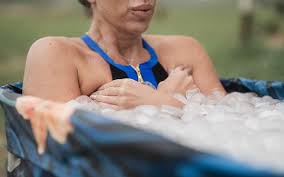If your social media feed looks anything like mine, you’ve seen the videos: people lowering themselves into ice baths with expressions ranging from meditative calm to barely contained panic. Cold plunge therapy has exploded from a niche recovery tool used by elite athletes into a mainstream wellness trend. But is there actual science behind the shiver, or is this just another wellness fad destined to melt away?
What Actually Happens When You Plunge
When you immerse yourself in cold water (typically between 50-59°F), your body goes into a controlled stress response. Blood vessels constrict, pushing blood toward your core to protect vital organs. Your heart rate increases, and you start breathing faster. It’s uncomfortable, sometimes intensely so, but proponents claim this controlled discomfort triggers a cascade of health benefits.
The practice isn’t new. Cold water immersion has been used therapeutically for centuries across different cultures. What is new is the growing body of research examining exactly what’s happening beneath the surface.
The Science-Backed Benefits
One of the most established benefits of cold plunge therapy is reduced inflammation and improved muscle recovery. Athletes have used ice baths for decades post-workout, and research supports this practice for reducing delayed onset muscle soreness. The cold constricts blood vessels and decreases metabolic activity, which reduces swelling and tissue breakdown.
Beyond physical recovery, cold exposure appears to influence mental health. The shock of cold water triggers the release of norepinephrine, a hormone and neurotransmitter that plays a role in focus and mood. Some studies suggest regular cold exposure may help with symptoms of depression and anxiety, though it’s important to note this isn’t a replacement for professional mental health treatment.
Cold plunges may also boost your immune system. Exposure to cold temperatures appears to increase the production of white blood cells, though the clinical significance of this effect is still being studied. Some practitioners report getting sick less frequently, but individual experiences vary widely.
Metabolic Effects and Brown Fat
Here’s where it gets interesting for those focused on metabolic health. Cold exposure activates brown adipose tissue, or brown fat, which burns calories to generate heat. Unlike regular white fat that stores energy, brown fat actually uses energy. Regular cold exposure may increase brown fat activity, potentially influencing metabolism, though don’t expect it to replace diet and exercise as weight management tools.
The Mental Game
Perhaps the most underrated benefit isn’t physical at all. The practice of voluntarily doing something uncomfortable builds mental resilience. You’re training your nervous system to stay calm under stress. That skill transfers beyond the ice bath into daily life, helping you manage stress and discomfort more effectively.
Many wellness centers and treatment facilities have recognized this benefit. High-end programs like Seasons Malibu have integrated cold plunge therapy into comprehensive wellness approaches, understanding that physical practices can support mental and emotional healing. The mental toughness developed through deliberate cold exposure can be surprisingly valuable in recovery and personal growth.
Is It Safe for Everyone?
Cold plunge therapy isn’t without risks. People with cardiovascular conditions, high blood pressure, or certain other health issues should consult their doctor before trying cold immersion. The shock of cold water can be dangerous for some individuals.
Start slow if you’re new to the practice. You don’t need to jump into a frozen lake. Even ending your regular shower with 30 seconds of cold water can provide benefits and help you build tolerance.
The Verdict
Cold plunge therapy appears to offer legitimate benefits, particularly for physical recovery, inflammation reduction, and possibly mental health. The research is promising but still evolving. It’s not a miracle cure, and it won’t solve all your health problems, but as part of a broader wellness routine, it’s more than just hype.
The key is consistency and finding what works for your body. Some people thrive on daily three-minute plunges. Others benefit from shorter, less frequent sessions. Like most health practices, the best approach is the one you’ll actually stick with.
If you’re curious about trying cold plunge therapy, consider starting small, listening to your body, and consulting with healthcare professionals if you have any underlying health conditions. The ice bath trend may eventually cool off, but the practice itself seems to staying power for good reason.


